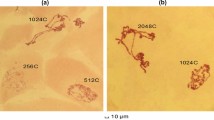Summary
-
1.
The extent of synapsis in hybridChrionomus larvae decreases with rising age.
-
2.
There is less synapsis in hybrid larvae grown at high (30° C.) and at low (13°C.) temperatures than in larvae kept at moderate temperatures (20–25°C.).
-
3.
In sectioned material of hybrid glands non-synapsed portions tend to be widely separated as though repelling one another.
-
4.
The results are discussed in the light of some recent theories on the nature of synaptic sttraction.
Similar content being viewed by others
References
Belehradek, J. (1935). Temperature and living matter. Gebr. Borntraeger. Berlin.
Bernal, J. D. (1940). Structural units in cellular physiology.Cell and Protoplasm. The Science Press.
Bryden, W. (1933). The relation of age to frequency of chiasma formation in the Wistar rat.J. Genet. 27.
Darlington, C. D. (1937). Rec. Adv. Cytology, London.
Delbrueck, M. (1941). A theory of autocatalytic synthesis of polypeptides and its application to the problem of chromosome reproduction.Symp. Quant. Biol. 9.
Fabergé, A. C. (1942). Homologous chromosome pairing. The physical problem.J. Genet. 43.
Fisher, P. C. (1944).Statistical methods for research workers. London.
Goldschmidt, E. (1942a). The pattern of salivary gland chromosomes.J. Hered. 33.
Goldschmidt, E. (1942b). Cytological studies inChironomidae. Summary of Thesis for the degree of Ph.D., The Hebrew University, Jerusalem.
Heilbrunn, L. V. (1928). The colloid chemistry of protoplasm. Gebr. Borntraeger. Berlin.
Mather, K. (1943).Statistical Analysis in Biology. London: Methuen.
Muller, H. J. (1940). Bearing of theDrosophila work on systematics.The New Systematics. Oxford.
Painter, T. S. (1941). An experimental study of salivary chromosomes.Symp. Quant. Biol. 9.
Plough, H. H. (1917). The effect of temperature on crossing over inDrosophila. J. Exp. Zool. 24.
Plough, H. H. (1921). Further studies on the effect of temperature on crossing-over.J. Exp. Biol. 32.
Schrader, F. (1944).Mitosis. Columbia University Press.
Smith, H. F. (1936). Influence of temperature on crossing-over inDrosophila. Nat. 138.
Stern, C. and Rentschler, V. (1936). The effect of temperature on the frequency of somatic crossing-over inDrosophila. Proc. Nat. Acad. Sci. 22.
White, M. J. D. (1934). The influence of temperature on chiasma frequency.J. Gen. 29.
Author information
Authors and Affiliations
Additional information
(With Six Text-figures)
Rights and permissions
About this article
Cite this article
Goldschmidt, E. Studies on the synapsis in salivary chromosomes of hybridChironomus larvae. Journ. of Genetics 48, 194–205 (1947). https://doi.org/10.1007/BF02989380
Issue Date:
DOI: https://doi.org/10.1007/BF02989380




